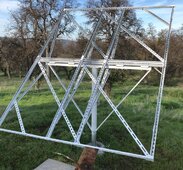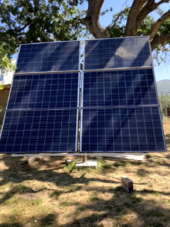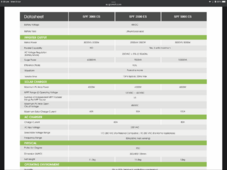Hi everyone,
It’s my first post here. I was recommended this forum by a friend in the hope to get some help for our upcoming off grid setup.
I am currently building a house in remote rural area in NSW Australia. There is no access to the grid but plenty of sun and we have a nice exposure for the Pv so we’re expecting a good yield all year round. ( 31° south for the nerds )
Now I am fairly new to the solar system and I understand the basics. I have successfully setup very basic 12v systems for cars, caravan, our mud kitchen… mainly with lead acid / AGM batteries. I am also familiar with basic household AC wiring, and I would be comfortable wiring a power board, wiring up a house myself having done a fair few jobs around my workshop and houses in the past…
The reason of my asking for advice on this forum is because I need some help figuring a good setup for our house which will be a much bigger system and as I understand it, mistakes can get not just costly but also dangerous especially with a lot of bigger panels, lithium batteries etc... I won’t be able to get a sparky in as it’s too far and probably to unconventionally designed for someone accredited to take on the job. So I want to know some opinions of what could be the best way to go about with our budget and what we already have bought over the last year.
So roughly a year ago, whilst we were still working on the very basic foundation of our house ( I do everything my self so it’s going rather slowly ) one of our neighbours has come forward and offered us to buy an integrated battery system from the company BYD namely a Mini ES with the optional additional base (3.5kw + 3kw of lithium running at 48V ) At the time I had done very little research on the subject and for the price he offered it it was hard to say no. It came from a retired electrician who was shutting down and selling on a few left over. The unit is brand new in its box. He bought 2 units so one came to him one to us.
) one of our neighbours has come forward and offered us to buy an integrated battery system from the company BYD namely a Mini ES with the optional additional base (3.5kw + 3kw of lithium running at 48V ) At the time I had done very little research on the subject and for the price he offered it it was hard to say no. It came from a retired electrician who was shutting down and selling on a few left over. The unit is brand new in its box. He bought 2 units so one came to him one to us.
After a little bit of reading and research it turns out this particular system is primarily designed to be used on the grid, with a PV inverter to plug into the box in AC and that the offgrid capacity of the built in DC/AC inverter for this unit was greatly reduced once off grid and the program would basically make it work as an emergency mode and therefore not an ideal solution for continuous running - barely 2Kw instead of 3.3kw of its standard capacity.
We were sort of relying on the fact that the neighbour was going to get the system running before we’d be ready to plug in ours and we’d just copy his setup, but obviously things have changed, I won’t go in all details but one of his electrician mate came around and tried to make it work and it went to a standstill - not entirely sure how competent that person is to be honest so I wouldn’t hold my breath - and he ended up buying another system as he came across another good deal for a newer system. He decided to just give us his box as it was easier than taking it out then deal with it. At this point I am not too far from starting building a stand alone roof structure for the solar panels ( I want enough room for 30 panels ( 2m by 1 panels ) but obviously I don’t want to start installing panels until I have figured out a design for the battery / controller / inverter and get everything. The batteries, controllers and inverter would be in a separate - purpose build shed near / underneath the solar roof. The house is approximately 25 metres away from the shed/ roof.
After talking to a few friends about it, we decided to first find out if the batteries were still good as they’re pretty old now. And after taking it apart, they do read 26.3v so they’re still charged. We’re going to run a vicron solar controller with one panel and have a device that puts a load on the battery and see what the app tells us after a few days. At this point I have no idea about the condition of the battery. I don’t even know if they will function with a different controller than the BYD. So I’ll keep you updated when I found out by the end of next week.
We also bought 10 solar panels 450w and i have another 20 @ 450w on the way.
We have a pretty simple idea. Since we live completely off grid, we produce our own food we would like to run a cool room / cellar as well as our house. For the cool room / cellar, it would take a couple of 3kw air conditioning unit with a coolbot in a refrigerated truck body that will be double walled for optimal insulation and minimum temperature variation. That would not be running non stop but only throughout the day whilst the sun is out. We would also like being able to run in the house a large fridge, a freezer, a computer, some lights, an oven. No microwave, no toaster, no kettle.
Our budget is tight but since we have already got 13Kw worth of lithium batteries and almost 13.5kw worth of panels. I’d like to know what would be the best setup for 2 separate systems: 1 for the house and 1 for the cellar.
I will add some more photos of the batteries when I get to it. This was just a quick one.
Happy to hear any good advice! Thanks

It’s my first post here. I was recommended this forum by a friend in the hope to get some help for our upcoming off grid setup.
I am currently building a house in remote rural area in NSW Australia. There is no access to the grid but plenty of sun and we have a nice exposure for the Pv so we’re expecting a good yield all year round. ( 31° south for the nerds )
Now I am fairly new to the solar system and I understand the basics. I have successfully setup very basic 12v systems for cars, caravan, our mud kitchen… mainly with lead acid / AGM batteries. I am also familiar with basic household AC wiring, and I would be comfortable wiring a power board, wiring up a house myself having done a fair few jobs around my workshop and houses in the past…
The reason of my asking for advice on this forum is because I need some help figuring a good setup for our house which will be a much bigger system and as I understand it, mistakes can get not just costly but also dangerous especially with a lot of bigger panels, lithium batteries etc... I won’t be able to get a sparky in as it’s too far and probably to unconventionally designed for someone accredited to take on the job. So I want to know some opinions of what could be the best way to go about with our budget and what we already have bought over the last year.
So roughly a year ago, whilst we were still working on the very basic foundation of our house ( I do everything my self so it’s going rather slowly
After a little bit of reading and research it turns out this particular system is primarily designed to be used on the grid, with a PV inverter to plug into the box in AC and that the offgrid capacity of the built in DC/AC inverter for this unit was greatly reduced once off grid and the program would basically make it work as an emergency mode and therefore not an ideal solution for continuous running - barely 2Kw instead of 3.3kw of its standard capacity.
We were sort of relying on the fact that the neighbour was going to get the system running before we’d be ready to plug in ours and we’d just copy his setup, but obviously things have changed, I won’t go in all details but one of his electrician mate came around and tried to make it work and it went to a standstill - not entirely sure how competent that person is to be honest so I wouldn’t hold my breath - and he ended up buying another system as he came across another good deal for a newer system. He decided to just give us his box as it was easier than taking it out then deal with it. At this point I am not too far from starting building a stand alone roof structure for the solar panels ( I want enough room for 30 panels ( 2m by 1 panels ) but obviously I don’t want to start installing panels until I have figured out a design for the battery / controller / inverter and get everything. The batteries, controllers and inverter would be in a separate - purpose build shed near / underneath the solar roof. The house is approximately 25 metres away from the shed/ roof.
After talking to a few friends about it, we decided to first find out if the batteries were still good as they’re pretty old now. And after taking it apart, they do read 26.3v so they’re still charged. We’re going to run a vicron solar controller with one panel and have a device that puts a load on the battery and see what the app tells us after a few days. At this point I have no idea about the condition of the battery. I don’t even know if they will function with a different controller than the BYD. So I’ll keep you updated when I found out by the end of next week.
We also bought 10 solar panels 450w and i have another 20 @ 450w on the way.
We have a pretty simple idea. Since we live completely off grid, we produce our own food we would like to run a cool room / cellar as well as our house. For the cool room / cellar, it would take a couple of 3kw air conditioning unit with a coolbot in a refrigerated truck body that will be double walled for optimal insulation and minimum temperature variation. That would not be running non stop but only throughout the day whilst the sun is out. We would also like being able to run in the house a large fridge, a freezer, a computer, some lights, an oven. No microwave, no toaster, no kettle.
Our budget is tight but since we have already got 13Kw worth of lithium batteries and almost 13.5kw worth of panels. I’d like to know what would be the best setup for 2 separate systems: 1 for the house and 1 for the cellar.
I will add some more photos of the batteries when I get to it. This was just a quick one.
Happy to hear any good advice! Thanks






